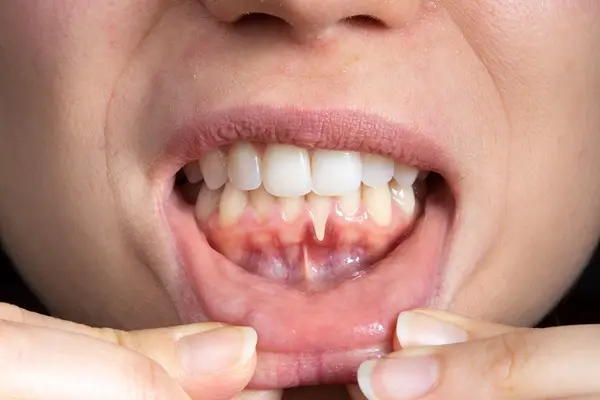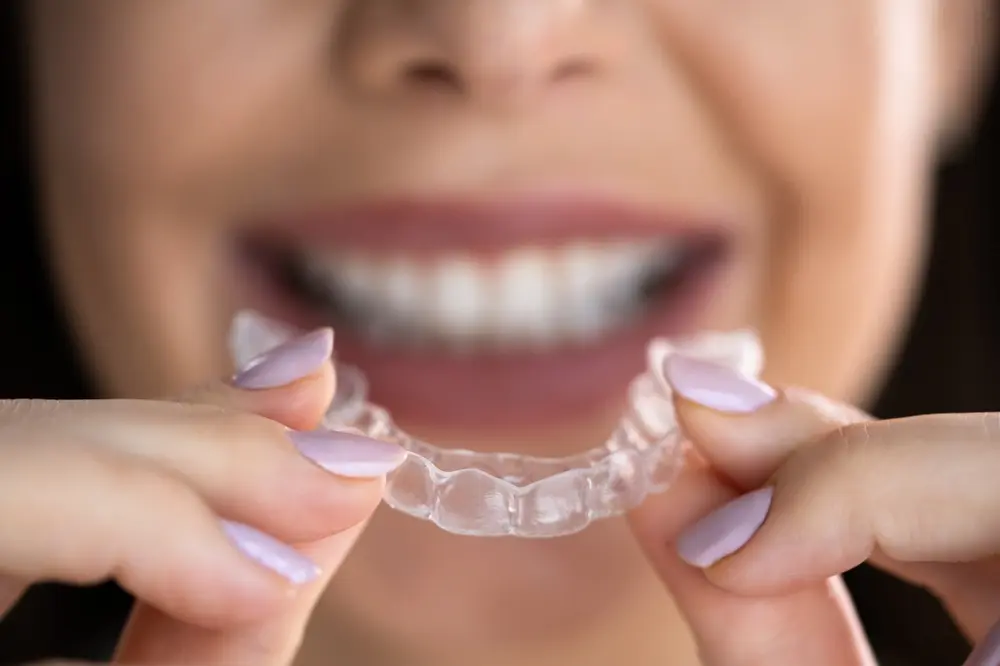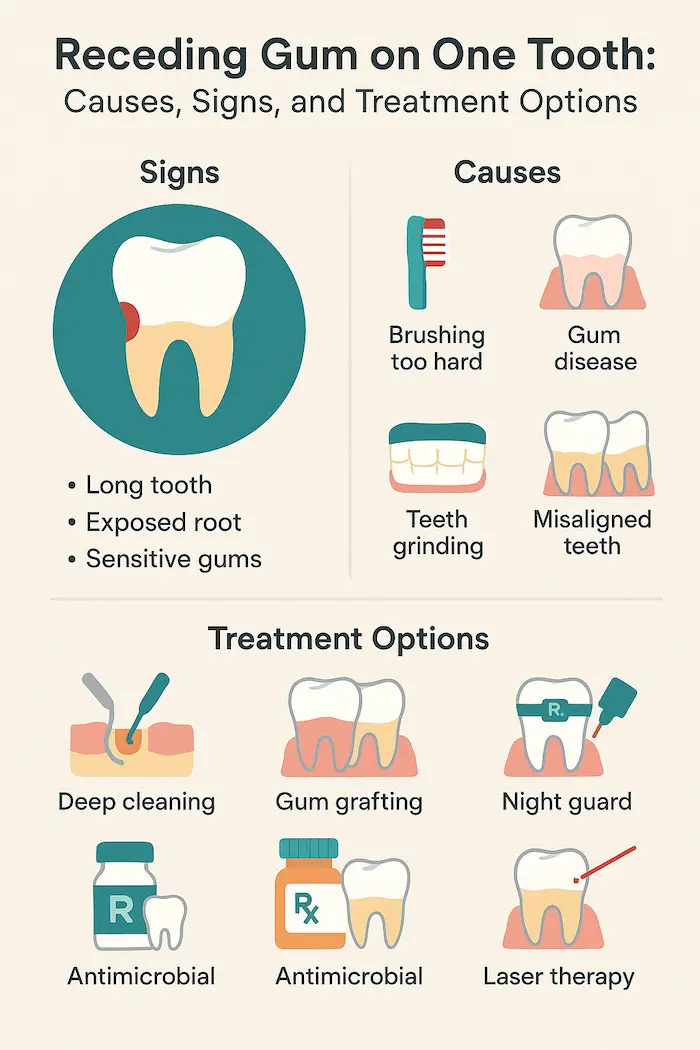Understanding Gum Recession on a Single Tooth
What is Gum Recession?
Did you know that nearly 88% of people over age 65 have recession affecting at least one tooth, but many cases begin much earlier in life? According to the Journal of the American Dental Association, gum recession affects up to half of adults between 18 and 64 years old, with many experiencing it on just a single tooth initially. The concerning part? Most people never notice until the recession becomes advanced.
Gum recession happens when the tissue surrounding a tooth wears away, exposing more of the tooth or its root. When recession affects just one tooth, it typically indicates something specific irritating that area. Left untreated, even isolated recession can progress to bigger dental issues down the road.
Common Causes of Single Tooth Gum Recession
How Brushing Too Hard Causes Gum Recession on One Tooth
Aggressive brushing ranks among the most common causes of localized gum recession. Using a hard bristled toothbrush or applying excessive pressure can gradually wear away gum tissue. Many people believe scrubbing harder equals cleaner teeth, but this damages sensitive gums.
Why Teeth Grinding Makes Your Gums Recede on Specific Teeth
Teeth grinding and clenching, known medically as bruxism, often leads to recession around specific teeth that bear the most force. Many people grind their teeth during sleep without realizing it. Morning jaw soreness or gradually chipping teeth might indicate nighttime grinding. The constant pressure stresses gums around certain teeth, causing them to recede over time.
How Crooked Teeth Contribute to Localized Gum Recession
Misaligned teeth create uneven pressure points that can lead to recession. When one tooth sits out of alignment or juts forward, its gum tissue experiences greater stress. Crowded teeth also prove difficult to clean properly, leading to plaque buildup that irritates gums and eventually causes them to pull back from affected teeth.
When Dental Work Causes Gum Recession on Adjacent Teeth
Poorly fitting dental restorations (fillings, crowns, etc.) sometimes contribute to recession. A crown or filling with rough edges or improper contours irritates surrounding gum tissue and traps bacteria. Even slightly rough surfaces can create ongoing irritation if not properly adjusted by your dentist.
How Smoking Affects Your Gums
Tobacco users face heightened risk for gum recession. Smoking and vaping restrict blood flow to gum tissues, hampering healing and making them more vulnerable to recession. Nicotine constricts blood vessels, often masking warning signs like bleeding or inflammation. Without these visible indicators, recession progresses unnoticed until significant tissue loss occurs. Research from the American Academy of Periodontology indicates tobacco users have twice the risk for gum disease compared to non-users, making them particularly vulnerable to recession.
Gum Disease
Gum disease plays a major role in recession. Early stage gingivitis can advance to periodontitis when left untreated. This more serious condition breaks down both bone and soft tissue supporting teeth. Even when most teeth remain unaffected, infection can target specific areas more aggressively, causing localized recession.
How Dental Injuries Lead to Gum Recession on a Single Tooth
Trauma or injury sometimes triggers recession around a single tooth. Sports accidents, falls, or even aggressive dental treatments can damage gum tissue. This type of recession might appear immediately after injury or develop gradually as tissue heals improperly.
Identifying Gum Recession on a Single Tooth

Receding gum sometimes can be easy to spot
How to Spot Food Traps Around Teeth with Receding Gums
Gum recession creates a pocket or gap between the tooth and gum line. This space traps food particles and bacteria, making cleaning difficult. You might notice your floss catching on that particular tooth or food regularly getting stuck in the same spot.
Why Exposed Tooth Roots Cause Sensitivity to Hot and Cold
Temperature sensitivity is often a good indicator of recession. When gums pull back, they expose the tooth root, which lacks the protective enamel coating found on the visible portion of teeth. This exposed area responds to hot, cold, sweet, or acidic foods and drinks.
Changes in Tooth Appearance
Visual changes provide clear indicators of recession. The affected tooth appears longer than surrounding teeth as more of its surface becomes visible. The gum line looks uneven, with a noticeable dip around the problem tooth. Sometimes a notch develops where the tooth meets the gum.
What Healthy vs. Receding Gums Look Like Around One Tooth
Color changes sometimes accompany recession. Healthy gums typically appear pink and firm. Receding gums often look redder, inflamed, or in advanced cases, pale from reduced blood flow.
Measuring the Severity of Gum Recession
How Dentists Measure and Classify Gum Recession Severity
Dentists classify gum recession using specific measurements. Class I recession involves minimal tissue loss that remains above the mucogingival junction. Class II recession extends to the junction but preserves interdental tissue. Class III recession shows interdental bone or soft tissue loss, with the gum margin positioned apically to the junction. Class IV, the most severe, features significant tissue loss around the entire tooth.
Why Professional Evaluation Is Crucial for Receding Gums
These classifications help determine appropriate treatment approaches. Early classification stages respond well to preventive measures and minor interventions, while advanced stages often require surgical correction. The Mayo Clinic provides detailed explanations of how dental professionals evaluate gum health and recession severity.
Professional Treatment Options for Receding Gums
Dental Examination and Diagnosis
Seeing your dentist is important if you suspect you have gum recession. Dentist will examine the affected area, measure recession depth, and identify underlying causes. The dentist will then recommend the best treatment options for you.
How Scaling and Root Planing Treats Gum Recession
Deep cleaning procedures help address bacterial causes of recession. Scaling and root planing remove plaque and tartar from below the gum line and smooth the root surface, making it harder for bacteria to reattach. This procedure helps gum tissue heal and prevents further recession.
How Gum Grafting Surgery Repairs Severely Receded Gums
Gum grafting helps repair moderate to severe recession. This minor surgical procedure involves taking healthy tissue from another part of your mouth (typically the palate) or using donor tissue to cover exposed roots. Grafts protect vulnerable roots, reduce sensitivity, improve appearance, and prevent additional recession.
Night Guards for Bruxism
Night guards protect against grinding related recession. They are custom fitted devices that provide a cushioning barrier between upper and lower teeth during sleep, distributing pressure evenly rather than concentrating it on specific teeth. They reduce both recession risk and related problems like jaw pain.

Night guard used to help with receding gum by preventing teeth grinding
When Braces or Aligners Can Help Stop Gum Recession
Orthodontic treatment sometimes helps prevent recession progression. Properly aligned teeth distribute biting forces evenly and prove easier to clean. Moving misaligned teeth into better positions reduces stress on gums and decreases recession risk.
How Antibiotics and Antimicrobial Treatments Fight Gum Infections
Antimicrobial treatments target infection related recession. Prescription rinses or locally applied antibiotics reduce harmful bacteria populations in gum pockets. These treatments help control infection and create conditions where gums can heal.
How Laser Therapy Treats Receding Gums Without Surgery
Laser therapy offers another approach for treating recession. Dental lasers precisely target bacteria and reshape gum tissue with minimal discomfort. Many patients report faster healing times compared to traditional procedures, though availability varies between dental practices.
Innovative Techniques for Gum Restoration
How the Pinhole Surgical Technique Repairs Receding Gums
Pinhole surgical technique provides a minimally invasive alternative to traditional grafting. This procedure involves making a tiny hole in the gum tissue, then using special instruments to loosen and reposition the gum over the exposed root. The National Institute of Dental and Craniofacial Research tracks emerging treatment approaches for gum conditions, providing updates on techniques that show promising results.
Platelet-Rich Fibrin Therapy
Platelet rich fibrin therapy utilizes growth factors from your own blood to enhance healing after gum procedures. This biological approach stimulates tissue regeneration and improves surgical outcomes. The concentrated healing factors accelerate recovery and potentially improve long term results.
Guided Tissue Regeneration
Guided tissue regeneration combines specialized membranes with bone grafting materials to encourage natural regrowth of both gum tissue and supporting bone. This comprehensive approach addresses multiple aspects of recession damage, particularly in cases involving bone loss.
Home Care Strategies for Receding Gums
Best Brushing Techniques to Prevent Further Gum Recession
Daily habits have a significant impact on gum health. Use a soft bristled toothbrush and gentle circular motions rather than aggressive scrubbing. Electric toothbrushes with pressure sensors help prevent applying excessive force during brushing.
How to Floss Properly Around Teeth with Receding Gums
Flossing properly cleans areas toothbrushes cannot reach. Daily flossing removes plaque from between teeth and along the gum line, preventing bacteria buildup that contributes to recession. Water flossers are a good alternative for people who struggle with traditional floss.
Diet and Gum Health
Diet affects gum health more than many realize. Reducing sugary foods and beverages limits fuel for harmful bacteria. Crunchy vegetables naturally clean teeth surfaces during chewing. Drinking plenty of water helps maintain adequate saliva production, which naturally cleans teeth and neutralizes acids.
Addressing dry mouth helps prevent recession. Saliva plays a crucial role in oral health by washing away food particles, neutralizing acids, and supporting remineralization. People with dry mouth from medications, medical conditions, or mouth breathing face increased recession risk. Sugar-free gum containing xylitol stimulates saliva flow and helps protect teeth.
How Regular Dental Visits Prevent Worsening Gum Recession
Regular dental checkups help catch minor recession before it becomes more serious. Professional cleanings remove hardened deposits ordinary brushing cannot eliminate. Dentists identify minor recession before significant damage occurs. Treatment proves most effective when started early.
Nutritional Support for Gum Health
How Vitamin C Helps Rebuild and Strengthen Receding Gums
Vitamin C deficiency contributes to gum problems, including reduced collagen production and impaired healing. Including foods rich in vitamin C such as citrus fruits, strawberries, bell peppers, and broccoli in your diet regularly supports gum tissue strength.
Best Calcium Sources for Strengthening Teeth and Gums
Calcium and vitamin D work together to maintain bone density, including the jawbone that supports teeth and gums. Dairy products, fortified plant milks, leafy greens, and modest sun exposure help maintain adequate levels of these nutrients.
How Omega-3 Fatty Acids Reduce Gum Inflammation
Omega-3 fatty acids possess anti-inflammatory properties that may reduce gum inflammation. Cold-water fish, flaxseeds, and walnuts provide these beneficial fats. Some studies suggest higher omega-3 intake correlates with lower rates of periodontal disease.
Best Antioxidant Foods for Fighting Gum Disease
Antioxidants combat oxidative stress that damages gum tissue. Colorful fruits and vegetables, green tea, and dark chocolate contain compounds that help neutralize harmful free radicals. Regular consumption supports overall gum health.
How Probiotics Improve Gum Health and Reduce Recession Risk
Probiotics influence oral microbiome balance, potentially reducing harmful bacteria populations. Fermented foods like yogurt, kefir, and sauerkraut contain beneficial bacteria that may support healthier gum tissue. The American Dental Association provides guidance on nutritional approaches to supporting dental health, including how specific nutrients affect gum tissue.
Managing Teeth with Receding Gums
Best Toothpastes for Sensitive Teeth with Receding Gums
Sensitive teeth products help manage discomfort from exposed roots. Toothpastes formulated specifically for sensitive teeth contain ingredients that block pain signals from nerve endings. These products require consistent use for several weeks before you see results.
How to Brush Gently Around Teeth with Receding Gums
Modified brushing techniques protect vulnerable areas. Dentists often recommend holding the brush at a 45-degree angle to the gum line and using gentle circular motions. Paying special attention to cleaning along the gum margin without applying excessive pressure helps prevent further damage.
Antimicrobial Rinses
Antimicrobial mouth rinses help control bacteria levels around receding areas. These rinses reduce plaque formation between brushing sessions. Alcohol free formulations prove gentler on sensitive gum tissue.
Reducing Risk Factors for Gum Recession
Stress Management
Stress management helps reduce unconscious behaviors like teeth grinding and clenching. Relaxation techniques, physical activity, and adequate sleep all contribute to lower stress levels. Some people benefit from professional counseling to develop healthy coping mechanisms.
How Quitting Smoking Improves Gum Health and Stops Recession
Tobacco cessation significantly improves gum health. Within weeks of quitting, blood flow increases to gum tissue, enhancing oxygen delivery and immune function. Multiple resources exist to support quitting, including medication, counseling, and support groups.
Medications That Can Cause Gum Recession as a Side Effect
Medication reviews sometimes identify drugs contributing to gum problems. Some medications cause dry mouth as a side effect, indirectly increasing recession risk. Others affect gum tissue directly. Discussing concerns with both dentist and physician helps identify alternatives when possible.
Custom Oral Care Plans for People Prone to Gum Recession
Customized oral hygiene routines address individual risk factors. People with recession on specific teeth often benefit from targeted cleaning approaches. Your dental team can demonstrate techniques tailored to your unique situation.
Long-term Management of Gum Health
How Gentle Daily Care Prevents Worsening Gum Recession
Consistency matters more than intensity with oral hygiene. Gentle, thorough cleaning twice daily protects gums better than occasional aggressive scrubbing. Establish a regular routine and stick with it.
Why to Replace Your Toothbrush
Replacing dental tools regularly maintains effectiveness. Toothbrushes or electric brush heads need replacement every three months or sooner if bristles become frayed. Old, worn brushes clean less effectively and sometimes damage gum tissue.
How to Monitor Your Gums for Signs of Worsening Recession
Monitoring changes helps catch progressing recession. Check your gums periodically using a mirror and good lighting. Note any teeth that appear longer than before or areas where gums look inflamed. Let your dentist know if you notice any changes.
How Genetics Affect Your Risk of Gum Recession
Genetics plays a role in recession susceptibility. Some people naturally have thinner gum tissue or tooth positioning that increases recession risk. Knowing your genetic predispositions helps develop appropriate preventive strategies.
How Diabetes and Other Health Conditions Affect Gum Recession
Systemic health conditions influence gum health. Diabetes, hormonal changes, autoimmune disorders, and certain medications affect gum tissue strength and healing ability. Managing these conditions through medical care contributes to better gum health.
When to See a Periodontist for Specialized Gum Treatment
Specialists sometimes provide advanced care. Periodontists specialize in gum health and offer treatments beyond what general dentists typically provide. Referral to a specialist becomes appropriate when recession proves severe or continues despite initial treatments.
Aesthetic Considerations for Receding Gums
How Receding Gums Affect Your Smile Appearance
Cosmetic concerns often motivate treatment. Many people feel self conscious about receded gums making teeth appear longer or creating dark spaces between teeth. Treatment options balance functional needs with aesthetic goals.
How Digital Imaging Shows Treatment Outcomes Before Starting
Digital smile d technologies allow visualization of expected treatment outcomes. These tools help patients understand how different approaches might affect their appearance, supporting informed decisions about treatment.
Temporary Cosmetic Solutions While Treating Receding Gums
Temporary cosmetic solutions sometimes bridge the gap during treatment. Dental bonding materials can mask minor recession during the healing phase after procedures. These interim measures provide psychological comfort during recovery.
Recovery and Treatment Outcomes
How Long Gum Treatments Take to Heal Completely
Recovery expectations vary between procedures. Minor interventions typically cause minimal discomfort lasting a few days. Surgical procedures might require 1-2 weeks before complete healing. Understanding typical recovery timelines helps patients plan appropriately.

Different treatment options for receding gums including deep cleaning, gum grafts, and preventive care
What to Do and Avoid After Gum Treatment Procedures
Post treatment care significantly impacts long term results. Following specific instructions about cleaning, eating, and activity restrictions improves healing outcomes. Most dentists provide detailed written guidelines following procedures.
What Success Rates to Expect from Gum Recession Treatments
Success rates remain high for most gum treatments when performed by qualified professionals. The American Academy of Periodontology tracks treatment outcomes, reporting over 85% success rates for most gum grafting procedures when patients follow recommended aftercare.
Advances in Gum Recession Treatment
How 3D Imaging Improves Gum Treatment Planning
Modern dental technology improves treatment outcomes. Digital imaging captures precise measurements of recession progression over time. Computer guided treatment planning enhances graft placement accuracy. These technologies make treatments more predictable and effective.
How Tissue Engineering Is Revolutionizing Gum Treatments
Tissue engineering advances offer promising developments. Researchers work on materials that stimulate natural gum regeneration. These approaches aim to provide alternatives to traditional grafting procedures, potentially with less discomfort and faster healing.
How Genetic Testing Personalizes Gum Recession Treatment
Genetic testing increasingly informs personalized treatment plans. Identifying specific genetic markers associated with inflammation responses helps predict which patients might benefit most from certain interventions. This targeted approach maximizes treatment effectiveness.
How Teledentistry Monitors Gum Healing Between Appointments
Teledentistry enables remote monitoring between office visits. Digital photography allows dentists to evaluate healing progress without requiring in-person appointments for every check. This convenience improves compliance with follow-up recommendations.
Practical Considerations for Treatment
Insurance Coverage for Gum Recession Treatments
Insurance coverage varies for recession treatments. Procedures considered medically necessary due to symptoms or progressive damage typically receive better coverage than purely cosmetic treatments. Dental offices often help patients navigate insurance requirements to maximize benefits.
Payment Plans and Financing for Gum Treatments
Payment plans make treatment more accessible. Many dental practices offer interest-free financing or extended payment options. These arrangements help patients receive timely care without financial strain.
When to Treat Receding Gums vs. When to Wait and Monitor
Treatment timing considerations affect outcomes. Addressing recession early generally requires less invasive procedures and produces better results. Delaying treatment typically leads to more complex interventions with longer recovery periods.
When to Get a Second Opinion About Gum Recession Treatment
Second opinions provide valuable perspective for complex cases. Seeking additional professional input helps clarify treatment options and ensures comprehensive care. Most dentists readily provide referrals when patients request alternative viewpoints.
How Combining Treatments Improves Gum Recession Outcomes
Combining treatments often yields optimal results. Many patients benefit from addressing multiple factors simultaneously, such as night guards for grinding plus improved brushing techniques and possibly grafting procedures. Comprehensive approaches typically produce longer-lasting outcomes than single interventions.
Gum recession affecting a single tooth often signals an underlying issue requiring attention. Identifying causes, seeking appropriate treatment, and maintaining consistent home care prevents minor recession from developing into serious dental problems. Colgate Professional offers detailed care guides specifically addressing localized gum recession, with step-by-step instructions for protecting vulnerable teeth.
With proper care, you can protect your gums, maintain oral health, and preserve your natural smile for years to come. Taking action when noticing recession around even one tooth helps prevent spreading issues and maintains both function and appearance.





